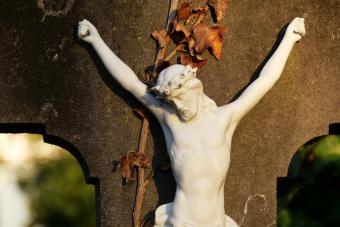
The crucifix is a central iconographic figure within Christian culture, and you might have seen an antique crucifix in a church's historical reliquary, in a personal collection, and even in a local antique store. If you grew up Catholic or in the Southern United States, your parents probably had a crucifix or two hanging up on the walls of your childhood home. Take a look at how this artistic rendering became so popular among Christian followers and what the crucifix collectors' market looks like today.
The Crucifix Throughout History
A crucifix is defined as a depiction of Christ dying on a cross, and the contemporary version of this depiction didn't appear until the Romanesque period in the 10th century. This includes Jesus Christ stretched between the beams of a wooden cross clothed in a thin white sheet around his hips and bearing a thorny crown. According to one artistic study, starting in the 13th century, artists began portraying Christ as a bloody martyr, with the spear wound in his side, the nail holes in his hands, and thorns puncturing his head causing rivulets of blood to stain his pale skin. This emphasis on pain and suffering continued until the 19th century, when the crucifix was sanitized of blood and often included a pensive or contemplative Christ. Modern artistic interpretations of this sacrificial scene are more interactive, and sometimes have Christ stretching out to reach for the viewer.
Materials and Styles of Antique Crucifixes
Antique crucifixes were crafted out of a myriad of materials and in a variety of styles. Most often, they were created out of different woods and metals, like brass and silver. In addition, many of these were also hand painted. The earliest crucifixes were mostly made out of wood; yet, both very old and more contemporary antique crucifixes were created in highly ornate and incredibly simple designs. Thus, you have to look more closely at the materials and the artist, if it's indicated, to evaluate the crucifix's date and worth.

How to Evaluate an Antique Crucifix
Whether you want to collect antique crucifixes or learn more about the one that your family considers an heirloom, you'll want to look at these different criteria that'll help you assess its value.
Condition
As with any antique, the antique crucifix's condition will have a large effect on its value. Look for any nicks or breaks, as well as for areas where the item may have been repaired. Also check for any missing pieces; while it will depreciate the value, you can have these pieces reattached if you're wanting to keep an antique crucifix that's already in your care. In addition, check that the figure of Christ looks like it was crafted out of the original artwork and isn't a replacement Christ that's been added on later.
Age
It can be rather difficult to age antique crucifixes, but medieval and Renaissance examples will often be worth more purely based on their age. Thus, if you think you might have an older crucifix, you'll want to reach out to an appraiser to get your antique officially assessed.

Style
Whether you're looking to buy or sell an antique crucifix, you're going to be at the mercy of the current market trends. As with most antiques, there is demand for certain styles and periods of collectors' items, meaning that you might not be able to sell that 11th century crucifix because there isn't anyone searching for it in the market right now. An easy way to check on these trends is to look at what's currently listed at different auctions and see if there's an abundance of a certain material, time period, or style. If the piece you're looking to sell is popularly represented, then now might be a great time to list it; on the flip side, if the same can be said for the kind you want to buy, then you're going to have to prepare to be a bit more competitive and perhaps spend more money to outbid another interested buyer.
Type
While most antique crucifixes were created to be mounted on a wall or above an altar, 19th and 20th century jewelers began creating delicate necklaces and broaches depicting the crucifix. These can be worth just as much, if not more, than the larger pieces are estimated to be worth.

Kriangkrai Thitimakorn / Moment / GettyImages The Christian cross, symbol of Christianity.
Antique Crucifix Values
Two major factors that influence antique crucifix values are the price of the materials used to craft them and the artists, if it's notated, that created them. In addition, the larger the piece, the more it's going to be worth. For example, this late-19th century hand-carved crucifix recently sold for nearly $8,000 in one online auction. The same can be said for crucifixes that come in other forms, like jewelry; this Edwardian crucifix pendant is listed in one auction for $500. In short, these antique crucifixes can be worth anywhere between a few hundred dollars to a few thousand dollars.
Bring History Into Your Home
Whether you want an antique crucifix to honor your religion or because you find them to be beautiful pieces of art, these items of cultural iconography can bring an old world feeling into anyone's space.







